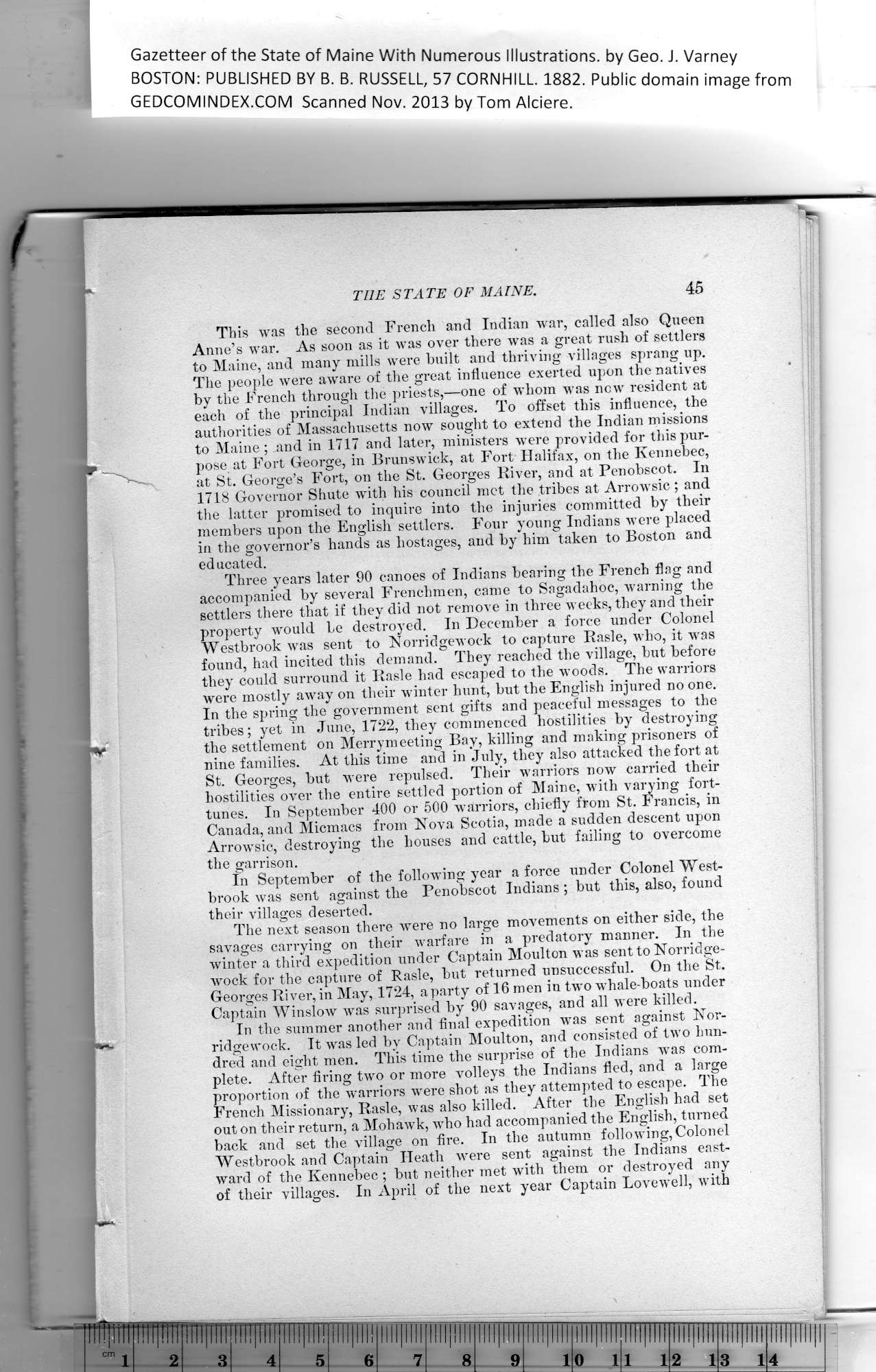|
Gazetteer of the State of Maine With Numerous Illustrations by Geo J Varnev
SSSSZ 7 er"-” C0™HI1L *■*
THE STATE OF MAINE.
This was the second French and Indian war, called also Queen
Anne’s war. As soon as it was over there was a great rush of settlers
to Maine, and many mills were built and thriving villages sprang up.
The people were aware of the great influence exerted upon the natives
by the French through the priests,—one of whom was new resident at
each of the principal Indian villages. To offset this influence, the
authorities of Massachusetts now sought to extend the Indian missions
to Maine ; and in 1717 and later, ministers were provided for this pur-
pose at Fort George, in Brunswick, at Fort Halifax, on the Kennebec,
at St. George’s Fort, on the St. Georges River, and at Penobscot. In
1718 Governor Shute with his council met the tribes at Arrowsic; and
the latter promised to inquire into the injuries committed by their
members upon the English settlers. Four young Indians were placed
in the governor’s hands as hostages, and by him taken to Boston and
educated.
Three years later 90 canoes of Indians hearing the French flag and
accompanied by several Frenchmen, came to Sagadahoc, warning the
settlers there that if they did not remove in three weeks, they and their
property would he destroyed. In December a force under Colonel
Westbrook was sent to Norridgewock to capture Rasle, who, it was
found, had incited this demand. They reached the village, but before
they could surround it Rasle had escaped to the woods. The warriors
were mostly away on their winter hunt, hut the English injured no one.
In the spring the government sent gifts and peaceful messages to the
tribes; yet in June, 1722, they commenced hostilities by destroying
the settlement on Merrymeeting Bay, killing and making prisoners of
nine families. At this time and in July, they also attacked the fort at
St. Georges, but were repulsed. Their warriors now carried their
hostilities over the entire settled portion of Maine, with varying fort-
tunes. In September 400 or 500 warriors, chiefly from St. Francis, in
Canada, and Micmacs from Nova Scotia, made a sudden descent upon
Arrowsic, destroying the houses and cattle, hut failing to overcome
the garrison.
In September of the following year a force under Colonel West-
brook was sent against the Penobscot Indians; but this, also, found
their villages deserted.
The next season there were no large movements on either side, the
savages carrying on their warfare in a predatory manner. In the
winter a third expedition under Captain Moulton was sent to Norridge-
wock for the capture of Rasle, but returned unsuccessful. On the St.
Georges River, in May, 1724, aparty of 16 men in two wrhale-boats under
Captain Winslow was surprised by 90 savages, and all were killed.
In the summer another and final expedition was sent against Nor-
ridgewock. It wras led by Captain Moulton, and consisted of two hun-
dred and eight men. This time the surprise of the Indians was com-
plete. After firing two or more volleys the Indians fled, and a large
proportion of the warriors were shot as they attempted to escape. The
French Missionary, Rasle, was also killed. After the English had set
out on their return, a Mohawk, who had accompanied the English, turned
back and set the village on fire. In the autumn following, Colonel
Westbrook and Captain Heath were sent against the Indians east-
ward of the Kennebec ; but neither met with them or destroyed ayy
of their villages. In April of the next year Captain Lovewell, with
|
ll!!|l!l! |
|
llll llll |
III! llll |
li'llllll |
llllllll! |
1 |
llll|llll |
llll|llll |
llllllll! |
iiiilir |
|
5 |
6 |
l\ |
8 |
9 |
l |
0 1 |
i i |
2 1 |
3 1 |
4 |
PREVIOUS PAGE ... NEXT PAGE
This page was written in HTML using a program written in Python 3.2
|
